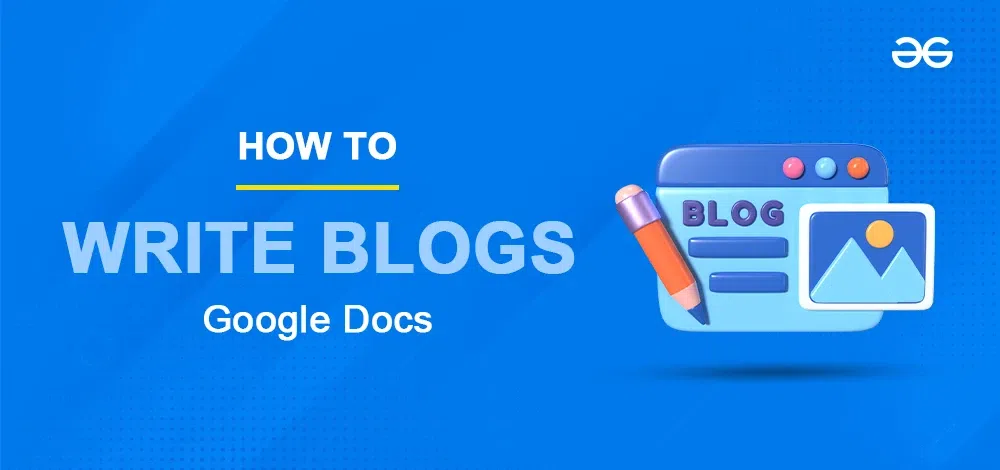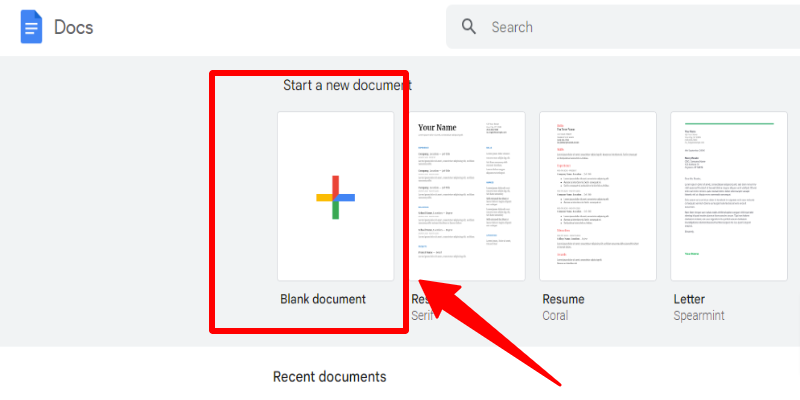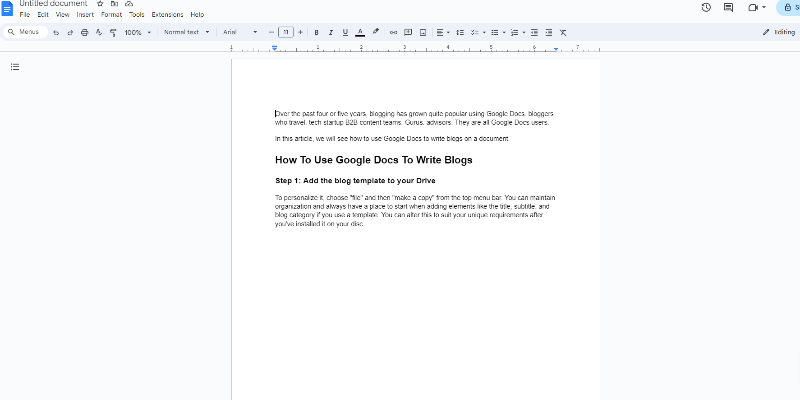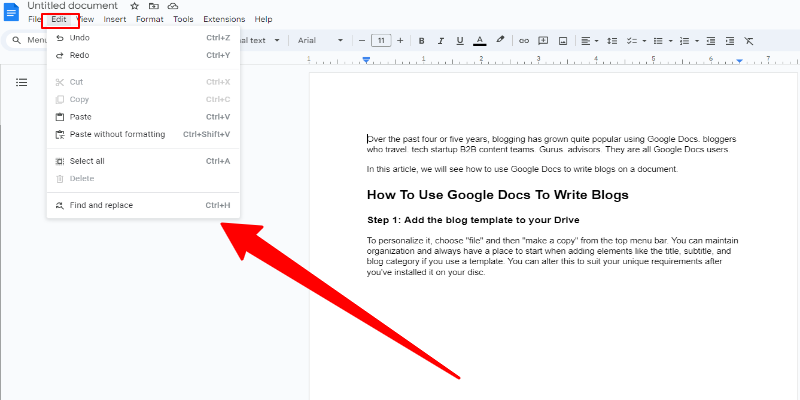Over the past four or five years, blogging has grown quite popular using Google Docs. bloggers who travel. tech startup B2B content teams. Among bloggers, creating blog articles with Google Docs as the content management system has become very popular. It’s an excellent option for content production because of its ease of use, collaborative capabilities, and intuitive UI. Bloggers can work together, monitor changes, and get comments inside the document with ease because of the robust editing tools and smooth connection with other Google services.
In this article, we will see how to use Google Docs to write blogs on a document.

Why Use Google Docs for Blog Post Templates
Google Docs is an excellent option for content production because of its ease of use, collaborative capabilities, and intuitive UI. To make the process of producing blog entries easier for you, we developed a simple Google Docs template. Using the hierarchical framework this template offers, you may better arrange your ideas, write more quickly, and keep your blog entries’ format constant.
6 Free Blog Post Templates
- Beginner’s guide blog post template
- Tips blog post template
- Cheat sheet blog post template
- Stats blog post template
- Round-up blog post template
- Steps blog post template
Google Docs Blog Post Template
Google Docs is a popular choice for blog post templates because of its collaborative capabilities, which include sharing, controlling editing rights, getting feedback, downloading and converting files, and cloud backup.
Introduction
The context of the problem you are going to address is established in the introduction.
This section focuses on why the problem is worthwhile to solve rather than offering detailed solutions. Here, you want to resonate with your audience so they will nod in accord.
With a few word changes, such an introduction might be used for any issue or product.
Body
The problem you introduced is explained in the body along with its answers.
Your reader is now prepared to hear your suggested remedy since you have helped them identify a problem.
You can use numbered lists, bullets, numerous headers, paragraphs, or a combination of these when writing your body. Use the format that is most convenient for you.
In order to help the reader achieve the objectives stated in your introduction, each part outlines what your product (or, again, service with very slight language modifications) should contain. The significance of it is then restated.
Conclusion
The conclusion summarises your article with a succinct sentence that reflects the problem that your post solved.
You may also use the conclusion to encourage your viewers to continue the topic in the comments section.
Filling in the Google Docs Blog Post Template

Free Google Docs Blog Post Templates
There are lots of free Google Docs Blog Post Templates but here is the sample of the blog.

Writing a Blog Post Template
The content in the template I’ve supplied here is not meant to be copied and pasted into every blog post you produce; doing so creates duplicate material, for which the search engines will penalize you severely.
It’s just intended to demonstrate the format you may use to compose a blog post since, in reality, there is a formula that makes it simple to produce material that is both quick and easy for you to write and beneficial for visitors.
As long as everything is written in its original language, feel free to replace any terms and phrases you find in the template with synonyms.
It’s also crucial to remember that while this blog post provides you with a template to get you started, there are other elements of a great blog post that you shouldn’t overlook.
As I mentioned before, a blog article wouldn’t be the same without a call to action. There’s no doubt that it wouldn’t aid in lead generation. And you ought to put some effort into creating a spectacular blog title if you want to increase click-through rates.
You should also consider optimization: did you incorporate relevant keywords and internal links to other website pages?
Finally, keep in mind that various content patterns for blogs also function well. Every blog article we create doesn’t have to have the same format, and we’ve seen several incredibly effective formats used by other sites.
How To Use Google Docs To Write Blogs
Step 1: Add the blog template to your Drive
To personalize it, choose “file” and then “make a copy” from the top menu bar. You can maintain organization and always have a place to start when adding elements like the title, subtitle, and blog category if you use a template. You can alter this to suit your unique requirements after you’ve installed it on your disc.
.png)
Step 2: Make a copy of the template
Your template is now prepared to be used in your Google Drive. To begin your first post, copy and paste it! You’ll always have the original template available for use if you follow this procedure. Choose “make a copy” from the menu when you right-click the document to create a duplicate of your template.

Step 3: Write your first draft
Write your own Google documents using proper headings, subtitles, and title of your blog

Step 4: Read it again, and edit it again.
You can read it and write it and also edit the documents.

Step 5: Read the draft, spell check, and make any edits
Before beginning this phase, put your draft on hold so you may return to it with fresh eyes! Examine the blog for yourself, and make any necessary edits like word count
.jpg)
Step 6: Share and receive feedback via “suggesting mode.”
The editing, suggesting, and watching options may be found in the top right corner. select the suggested mode Carefully review and revise the text for further improvement.
.png)
Step 7: Publish time
After you’ve reviewed the suggested adjustments and accepted or refused them, your paper should be ready to go! Copy and paste the material into your WordPress any blogger sites, upload bolding and font sizing if needed, then upload your photos and tweak your SEO. You can download in pdf and Word format You should be ready to publish!
.jpg)
Conclusion
Google Docs is the finest tool for creating blogs. It’s collaborative and comes with a plethora of productivity features right out of the box. Furthermore, it provides several add-ons and other tools to help you improve the quality (and frequency) of your blog postings.
FAQs
Can I write a blog on Google Docs?
Yes can write a blog on Google Docs .
Is Google Docs good for blogging?
Yes, Its user-friendly layout, collaboration capabilities, and ease of use make it an excellent option for creating content. Bloggers can work together, monitor changes, and get comments inside the document with ease because to the robust editing tools and smooth connection with other Google services.
How do I convert a Google Doc to Blogger?
Go to Google Docs and choose “upload.” Click “start upload” after selecting the document file you wish to upload. After the upload is finished, choose “blogger” with a right-click on the name of the document file. This will open the “new post” window in your blog account.
How can I create a blog on Google?
Create a Google Docs account. Decide on the type of blog you wish to start.
Choose a name for your blog. Make it clear to readers what your site is about.
Select a template for your blog. Tailor its design to your personal taste.
Compose and release your debut article.
Publish your blog.
Share your thoughts in the comments
Please Login to comment...